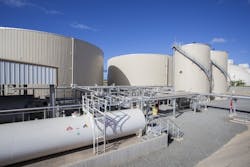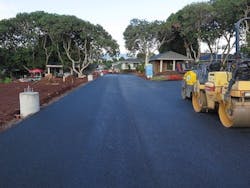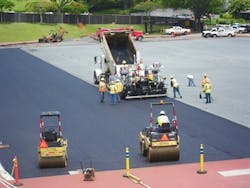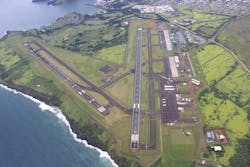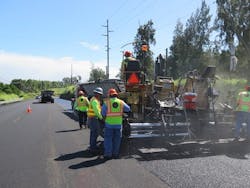How a Kalaeloa facility has served the asphalt industry in Hawaii for over a decade
For many years, two local oil refineries in Hawaii supplied asphalt binder to the paving industry. After one of the refineries (Chevron) stopped production of asphalt in 2006, the construction industry began to experience an unstable supply of asphalt from the remaining supplier. This resulted in periods of as long as six weeks with no available asphalt to meet contractual obligations and to maintain Hawaii’s roads. These shortages caused disruptions in the entire construction industry.
In response to these disruptions, an industry consortium consisting of the largest users of asphalt in Hawaii conducted research to determine the viability of constructing a facility to accept, store, and dispense imported asphalt. The group determined the undertaking to be feasible and began design and permitting on the project in Spring 2006. They broke ground for the new facility just 15 months later. By summer 2008, after 16 months of construction, the plant was operational and received its first load of asphalt.
ABOUT THE TERMINAL
The Kalaeloa Asphalt Terminal—operated by Asphalt Hawaii—was designed to facilitate the importation and distribution of liquid asphalt for the Hawaiian Islands. In this role, the terminal needed to be able to accept asphalt tanker-sized cargos into storage and be able to provide longer-term storage, as well as accommodate the loading of trucks and bulk containers for distribution of the asphalt throughout the islands. The Terminal provides a steady supply of consistent-quality asphalt essential to the success of the construction industry in Hawaii.
Using an innovative design approach that incorporates a high-efficiency thermal fluid heating system and is equipped for future addition of controls for energy savings, it is viewed as one of the finest terminals of its kind in the U.S. With a storage capacity of 300,000 barrels of asphalt, the facility easily meets the demands of the asphalt industry in Hawaii. In addition to utilizing local design services, a total of 125,000 injury-free construction man-hours were generated during construction of the project. Five full-time jobs were created to manage the facility.
MODIFIED ASPHALT CAPABILITIES
In 2014, the Terminal was upgraded to include polymer modified asphalt (PMA) production. PMA is an engineered product that improves the viscoelastic properties of asphalt with the addition of a modifier. One of the most widely-used modifiers for asphalt pavement binders, and the one used at the Terminal, is styrene-butadiene-styrene (SBS) polymer, an elastomer which is a synthetic rubber thermoplastic granulate that can be shaped by heat. The SBS polymer technology was developed in the 1970s by Houston-based Kraton Performance Polymers Inc. The polymer and the asphalt binder are pre-blended at the Terminal and then transported to the asphalt plants throughout the island chain.
Asphalt binder is modified to achieve the following improvements:
- Increased stiffness of the pavement, which reduces deformation
- Improved recovery of flexible pavements under heavy loads, which reduces rutting and shoving
- Lower stiffness and faster relaxation properties at low service temperatures, which reduces thermal cracking
- Increased adhesion between the asphalt binder and the aggregate in the presence of moisture, which reduces the likelihood of stripping
- Extended pavement service life
AIRFIELD PROJECTS AND PRODUCTS
The Hawaii DOT (HDOT) Airports Division has been specifying a modified binder, which became available after the Terminal’s upgrade in 2014, for many of their airfield pavements.
Completed projects:
- “Taxiway Z Structural Improvements,” at HNL used a PG 76-22 modified binder: The primary work included reconstruction of just over a mile-long taxiway using cast-in-place concrete. However, the grading of the new taxiway work did not match existing ground. Asphalt pavement was used to provide a 7.5-ft-wide transition between the new taxiway and the existing pavement.
- “NDWP Widen Taxilanes G & L – Phase I,” at HNL used a PG 70-22 modified binder: The taxilanes were originally designed and built for smaller aircrafts. With the introduction of newer, larger planes, the pavement has needed more frequent maintenance. The project improved the taxilanes by widening and providing a stronger surface through pavement reconstruction and overlays to allow any aircraft to travel them with no damage. In addition, environmental upgrades were also included in scope of work to allow for better drainage of the entire area.
- “Repave Airport Apron, Phase I” at Kalaeloa Airport used a PG 76-22 modified binder: Kalaeloa Airport is located on the west side of Oahu. The scope of work consisted of asphalt pavement removal and replacement of the General Aviation Apron with a new 2.5-in.-thick asphalt pavement.
Ongoing construction projects:
- “Airfield Runway 8L Widening, Phase 1” at HNL using a PG 76-22 modified binder: The runway (8L-26R) is 12,312 ft long and one of four runways at HNL. The scope of work is the resurfacing and widening of runway 8L-26R and repaving of associated taxiways. Other improvements include the construction of a new arresting barrier, updated markings, signage, and lighting to comply with current FAA and airport standards.
- “Runway 3-21 and Taxiway B Rehabilitation” at Lihue Airport using a PG 76-22 modified binder: Runway 3-21 is 6,500 ft long and is one of two runways at the airport. The project requires the milling of the existing pavement and repaving the Runway 3-21, Taxiway B, and adjoining taxiways with a nominally 4-in.-thick asphalt concrete pavement. Other improvements include pavement markings and grooving of the resurfaced areas.
- “NDWP IIT Mauka Extension” at HNL using PG 70-22 modified binder: The new 280,000-sq-ft building extension will expand the existing interisland terminal (IIT) building in the mauka (towards the mountains) direction. The gates added by the extension will accommodate six wide-body or 11 narrow-body aircrafts. Asphalt paving improvements include the construction of aircraft parking apron and airfield pavement.
Upcoming projects using a modified binder include the following:
- “Reconstruct Runway 3-21 at Lanai Airport” (PG 76-22)
- “Airfield Drainage Improvements” at Hilo Airport (PG 76-22)
- “Corrosion Control Hangar & Parking Facility” at Marine Corps Base Hawaii (PG 76-22)
- “Diamond Head Apron Reconstruction Gates G1 to G6” at HNL (PG 76-22)
- “KOA Federal Inspection Services Building” at Kona Airport (PG 70-22)
Fuel resistant asphalt (FRA) is another product that could be considered for airfield pavements. FRA is a viable alternative to coal tar sealers. FRA was first developed in the Netherlands and has been used at several international airports. FRA was first used in the U.S. at La Guardia Airport in New York in 2002 and then as a fuel-resistant apron application at Boston’s Logan International Airport in 2004 and in 2005. The Kalaeloa Terminal is currently developing a process to produce FRA in anticipation of a project requiring that specification of asphalt binder.
OTHER PROJECTS
Outside the airports, the Terminal has produced modified asphalt binders for gap-graded mixes, such as Stone Matrix Asphalt (SMA), as well as open-graded mixes.
In 2014, SMA was used as the surface course for the Interstate Route H-1 rehabilitation project in Honolulu. The project launched the use of a locally produced modified asphalt binder (PG 76-22) for the SMA on this job. The HDOT Highways Division believed that the SMA could better handle the 200,000 vehicles that use this 3-mile corridor each day.
In 2017, the section of Hawaii Belt Road in the Ka’awali’i Gulch on the rainy east coast of Hawaii Island was paved using Open-Graded Friction Course (OGFC) to improve both safety (it eliminated splashing) and improve surface friction.
Another type of open-graded mixture is porous asphalt. One use of this mixture has been to facilitate rapid drainage of a school’s athletic field in Honolulu. The typical field section was designed to have any water falling on the field flow through the turf and then through a layer of porous asphalt into a permeable aggregate base course. Rain no longer takes the field out of commission.
This mixture also serves as a low-impact development (LID) improvement approved for use in the city and county of Honolulu's recently implemented Water Quality Rules. To comply with the rules, a 300-ft-long, 20-ft-wide private driveway as part of a residential development in central Oahu was the first use of porous asphalt for a road or parking lot in Hawaii.
THE FUTURE
Since 2014, HAPI has been in discussions with various government agencies about the use of a modified binder in dense graded mixtures. The asphalt industry has suggested it be used for high-volume traffic roads on Oahu, such as King Street, Beretania Street, Kapiolani Boulevard, Nimitz Highway, and Ala Moana Boulevard. HDOT has been considering using SMA on several of their upcoming projects.
Going forward, Asphalt Hawaii will continue to provide the right asphalt binder for the right project.
